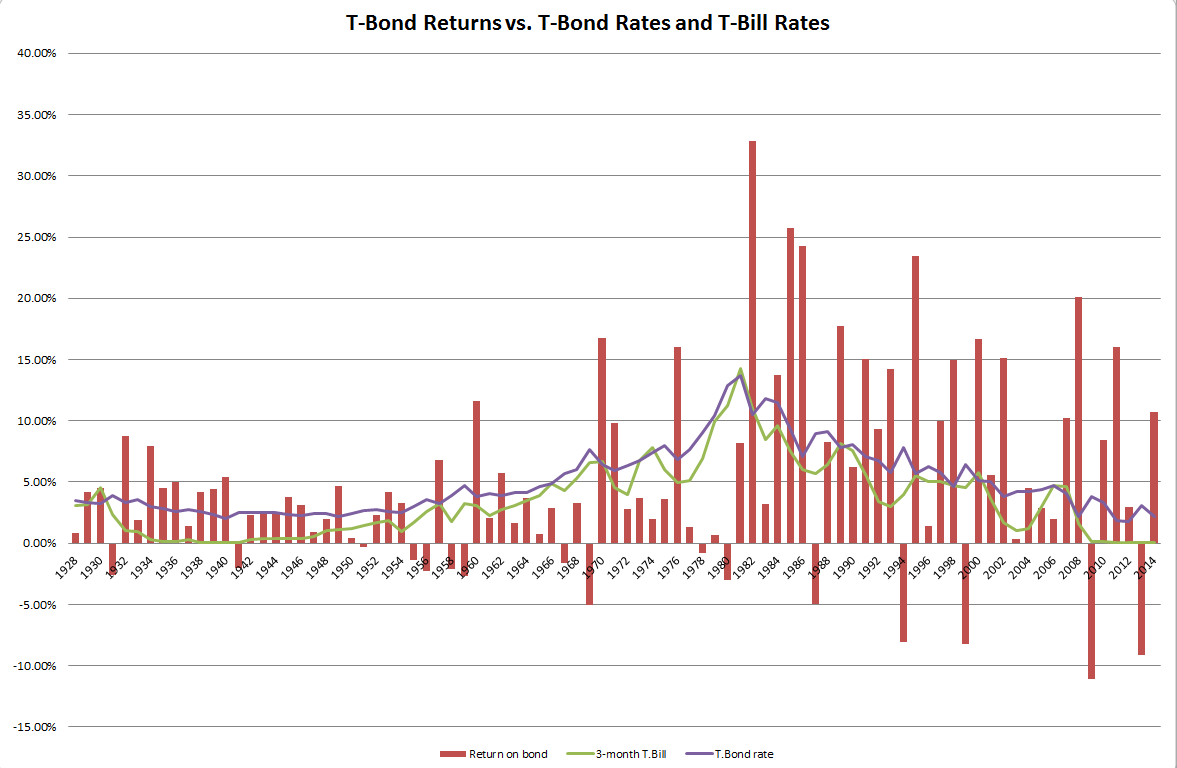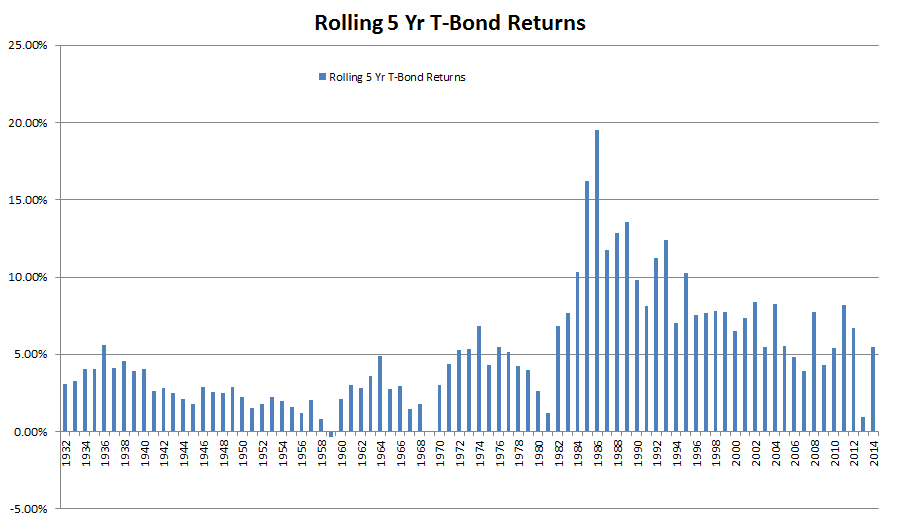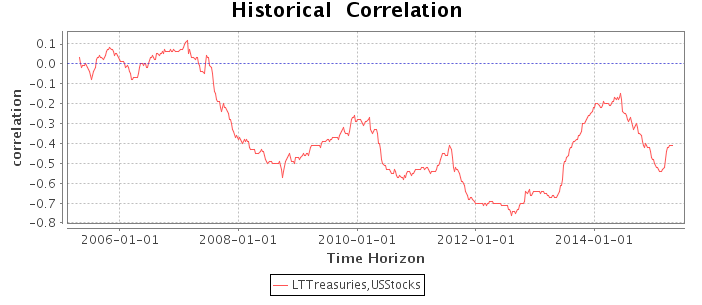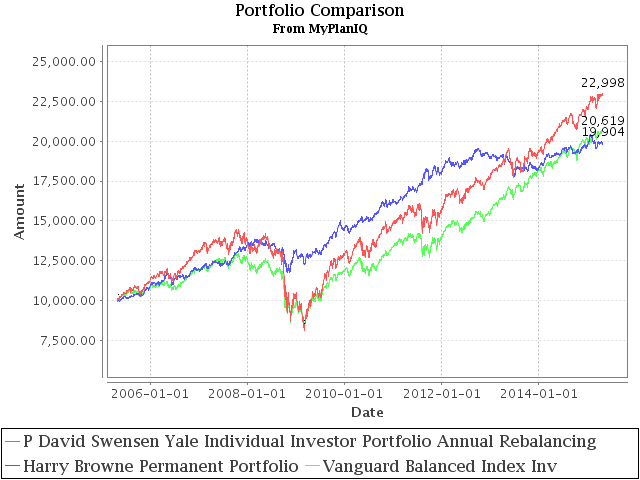Re-balance Cycle Reminder All MyPlanIQ’s newsletters are archived here.
For regular SAA and TAA portfolios, the next re-balance will be on Monday, May 18, 2015. You can also find the re-balance calendar for 2014 on ‘Dashboard‘ page once you log in.
As a reminder to expert users: advanced portfolios are still re-balanced based on their original re-balance schedules and they are not the same as those used in Strategic and Tactical Asset Allocation (SAA and TAA) portfolios of a plan.
Please note that we now list the next re-balance date on every portfolio page.
Long Term Treasury Bond Behavior
We have written several times on long term bonds. As many of our portfolios have long term bonds as candidate investments, we think that it deserves more investigation. In this newsletter, we will take a closer look at these investments.
Long term bonds usually are referred to bonds that have more than 7 year maturity. There are many types of long term bonds. They can be corporate bonds, Treasury bonds, municipal bonds. Within long term bonds, they can be also classified with their credit ratings. iShares long term investment grade corporate bonds LQD is an ETF that invests in investment grade corporate bonds with long term maturities. The most famous long term Treasury bonds are the 10 year Treasury bonds, usually referred as T-Bond. As a terminology, the shortest term Treasury debt is called T-Bill whose maturity is 13 week. T-Bill is usually used as a proxy to Cash, which is what MyPlanIQ CASH symbol represents.
T-Bond Historical Behavior
At the moment, 10 year Treasury bond (T-Bond)’s interest rate is 1.92%, close to historical low. The following chart shows its historical year by year returns since 1928 (data are from NYU Stern’s data, maintained by Professor Aswath Damodaran).
From the chart, we can see that 1958 has the worst back to back returns: there were 2 back to back losses in its past 5 years. We also see that recently, T-Bond returns have become quite volatile: in 1982, it had the biggest one year return (32.81%) while in 2009, the biggest one year loss (-11.12%).
However, if we take a look at its 5 year rolling returns:
In the past 87 years from 1928 to 2014, there was only one time (in 1958) of 5 year rolling return loss! The following table shows other stats on T-Bonds and stocks (S&P 500):
|
Annualized Returns (Since 1927) |
Standard Deviation |
Maximum Drawdown |
|
| T-Bond | 5% | 10.4% (Since 1989, Vanguard VUSTX) | 18.4% (Since 1989, Vanguard VUSTX) |
| S&P 500 | 9.6% | 9.6% (Since 1987, Vanguard VFINX) | 55.3% (Since 1987, Vanguard VFINX) |
Some other observations:
- T-Bond rate reached post the Great Depression low at 2.01% in 1940. This was in the midst of World War II.
- T-Bond rate started to climb steadily after WWII, since 1949. In fact it continued to rise for the 3 decades (50s, 60s and 70s) and reached the highest level in 1981.
- In the above rising rate period, T-Bond had several years of negative returns, the overall annualized returns from 1950 to 1981 is 2.8%, about half of its historical average returns. Notice in the 1970s (from 1970 to 1979), T-Bond returned 5.4%.
- Since then, it has descended for another 3 decades, reaching the lowest level in 2012 at 1.76%.
- From 1982 to 2014, it had an annualized return of 8.4%.
- T-Bill stayed in the sub zero range from 1933 to 1947. Since 2009, it has stayed close to 0 till now, lower than those in the first sub zero period.
Negative correlation with stocks
Based on the above data, one should always take the recent history with a grain of salt as over the past 33 years, interest rates have been in general declining. For example, the following chart shows how long term Tresasury bonds are correlated with US stocks (from Asset Trends & Correlation):
T-Bond has been negatively correlated with US stocks most of times. This means that when stocks go up, they tend to go down or vice versus.
Long term bonds as hedge
Several prominent lazy (or static or strategic) portfolios have allocation to T-Bonds. The first comes to mind is the famous David Swensen Yale Individual Investor Portfolio, Swensen specifically talked about using long term Treasury bonds as hedge:
“The purity of noncallable, long-term, default-free Treasury bonds provides the most powerful diversification to investor portfolios”.
In the portfolio, half of the 30% fixed income (bond) allocation is in long term Treasury bonds, making it one of the few conventional lazy portfolios that aggressively invests in T-bonds. Perhaps realizing that the volatile nature of T-bonds might not be entirely suitable to average individual investors, Swensen on other occasions recommended intermediate term Treasury bonds instead of the long term T-Bonds.
Another more aggressive usage of T-Bonds is Harry Browne Permanent Portfolio. Harry Browne advocates allocating 25% to T-Bonds. On Long Term Harry Browne’s Permanent Portfolio Performance, we have maintained a year by year performance table of this portfolio that started in 1970. Notice that since the U.S. officially ended gold standard in 1971, it was hard if not impossible to construct the Permanent Portfolio before 1970.
Interestingly, the Permanent Portfolio actually achieved a high 12.63% annual return in the 1970s, a period of rising interest rate (as mentioned previously). The performance in this period was actually not affected by T-Bond’s ‘normal’ returns (as stated above, 5.4% annually) even though in this period, interest rate rose dramatically.
The following table and chart show how these two portfolios have performed recently:
Portfolio Performance Comparison (as of 4/27/2015):
| Ticker/Portfolio Name | YTD Return** |
1Yr AR | 3Yr AR | 5Yr AR | 10Yr AR | 10Yr Sharpe |
|---|---|---|---|---|---|---|
| Harry Browne Permanent Portfolio | 1.4% | 4.1% | 2.0% | 5.8% | 7.1% | 0.86 |
| P David Swensen Yale Individual Investor Portfolio Annual Rebalancing | 4.6% | 13.3% | 10.6% | 10.9% | 8.7% | 0.52 |
| VBINX (Vanguard Balanced Index Inv) | 3.2% | 10.9% | 11.8% | 10.3% | 7.6% | 0.55 |
Take away
From what we have seen so far, long term bond behaves more volatile than most other bonds. If history is any guide (or no guide),we have the following take away:
- Long term bonds should be treated as a special asset class, instead of simply lumping them to ‘safe’ bond category.
- We are now in a somewhat uncharted territory as both T-Bill and T-Bonds rates are already lower than those in the Great Depression era. However, it is also quite possible that we will be (or already) in a similar period as 1950s to early 1980s: a rising rate environment that saw quite some dramatic rate rising.
- Long term bonds have been used as hedge for many famous portfolios. For the past 30-40 years, they have shown to be an effective portfolio hedge. However, from the data above, one should understand this period mostly represents a declining rate environment. To extrapolate the past performance in the future environment where rates will rise is problematic.
- Our position is that for strategic portfolios, one should only allocate a small portion to the long term bonds. We prefer adopting a more active approach to handle/utilize long term bonds such as portfolios like P Goldman Sachs Global Tactical Include Emerging Market Diversified Bonds ETFs.
- Finally, from the historical data (especially in the low and slow rising period in the Great Depression to WWII), one should expect a low overall return from buy and hold long term bonds. We note that even though T-Bond achieved 5.4% annual return in the 70s, at that time, T-Bond interest rate was already above 5% (and eventually rose to over 10% in 1979).
Market Overview
US stock markets rose to record territory. Nasdaq composite finally surpassed its peak in 2000, 15 years later. For now, we are seeing weak performance in rate sensitive investments such as long term bonds and REITs. However, given many weak macro economic indicators, markets have been tried and erred to find their directions.
For more detailed asset trend scores, please refer to 360° Market Overview.
We would like to remind our readers that markets are more precarious now than other times in the last 5 years. It is a good time and imperative to adjust to a risk level you are comfortable with right now. However, recognizing our deficiency to predict the markets, we will stay on course.
We again copy our position statements (from previous newsletters):
Our position has not changed: We still maintain our cautious attitude to the recent stock market strength. Again, we have not seen any meaningful or substantial structural change in the U.S., European and emerging market economies. However, we will let markets sort this out and will try to take advantage over its irrational behavior if it is possible.
We again would like to stress for any new investor and new money, the best way to step into this kind of markets is through dollar cost average (DCA), i.e. invest and/or follow a model portfolio in several phases (such as 2 or 3 months) instead of the whole sum at one shot.
Latest Articles
- April 20, 2015: 529 College Savings Plan Rebalance Policy Change
- April 13, 2015: Total Return Bond Funds As Smart Cash
- April 6, 2015: The Low Return Environment
- March 30, 2015: Brokerage Specific Core Mutual Fund Portfolios 2
- March 23, 2015: Investment Arithmetic for Long Term Investments
- March 16, 2015: Brokerage Specific Core Mutual Fund Portfolios
- March 9, 2015: Newsletter Collection Update
- March 2, 2015: Total Return Bond ETFs
- February 23, 2015: Why Is Global Tactical Asset Allocation Not Popular?
- February 16, 2015: Where Are Permanent Portfolios Going?
- February 9, 2015: How Have Asset Allocation Funds Done?
- February 2, 2015: Risk Management Everywhere
- January 26, 2015: Composite Portfolios Review
- January 19, 2015: Fixed Income Investing Review
- January 12, 2015: How Does Trend Following Tactical Asset Allocation Strategy Deliver Returns
- January 5, 2015: When Forecast Fails
- December 22, 2014: Long Term Asset Returns: How Long Is Long?
- December 15, 2014: Beaten Down Assets
- December 8, 2014: Implementing Core Asset Portfolios In a Brokerage
- December 1, 2014: Two Key Issues of Investment Strategies
- November 24, 2014: Holiday Readings
- November 17, 2014: Retirement Spending Portfolios Update
- November 10, 2014: Fixed Income Or Cash
- November 3, 2014: Asset Trend Review
- October 27, 2014: Investment Loss, Mistakes And Market Cycles
- October 20, 2014: Strategic Portfolios With Managed Volatility
- October 13, 2014: Embrace Volatility
- October 6, 2014: Tips For 401k Open Enrollment
- September 29, 2014: What Can We Learn From Bill Gross’ Departure From PIMCO?
- September 22, 2014: Why Total Return Bond Funds?
- September 15, 2014: Equity And Total Return Bond Fund Composite Portfolios
- September 8, 2014: Momentum Based Portfolios Review
- September 1, 2014: Risk & Diversification: Mint.com Interview
- August 25, 2014: Remember Risk
- August 18, 2014: Consistency, The Most Important Edge In Investing: Tactical Case
- August 11, 2014: What To Do In Overvalued Stock Markets
- August 4, 2014: Is This The Peak Or Correction?
- July 28, 2014: Stock Musings
- July 21, 2014: Permanent Portfolios & Four Pillar Foundation Based Framework
- July 14, 2014: Composite Portfolios Review
- July 7, 2014: Portfolio Behavior During Market Corrections
- June 30, 2014: Half Year Brokerage ETF and Mutual Fund Portfolios Review
- June 23, 2014: Newsletter Collection Update
- June 16, 2014: There Are Always Lottery Winners
- June 9, 2014: The Arithmetic of Investment Mistakes
- June 2, 2014: Tips On Portfolio Rebalance
- May 26, 2014: In Praise Of Low Cost Core Asset Class Based Portfolios
- May 19, 2014: Consistency, The Most Important Edge In Investing: Strategic Case
- May 12, 2014: How To Handle An Elevated Overvalued Market
- May 5, 2014: Asset Allocation Funds Review
- April 28, 2014: Now The Economy Backs To The ‘Old Normal’, Should Our Investments Too?
- April 21, 2014: Total Return Bond Investing In The Current Market Environment
Enjoy Newsletter
How can we improve this newsletter? Please take our survey
–Thanks to those who have already contributed — we appreciate it.






 Diversified Asset Allocation Portfolios For Your Plans
Diversified Asset Allocation Portfolios For Your Plans
